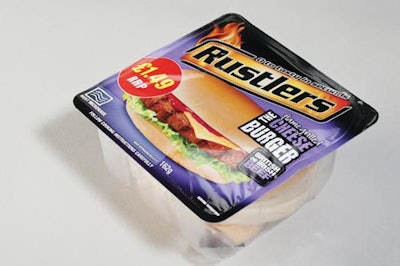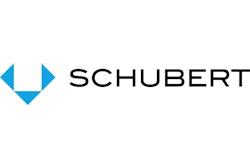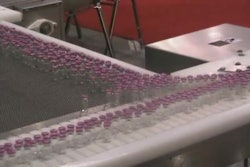Compared to Kepak’s previous, semi-automated packaging system, this concept has made a considerable difference in the line’s average output performance. Since temporary delays in one section of the line are automatically compensated for without the need for buffering systems, the line has reached a speed of 88 packs/min.
Before changing over to the new line in spring 2010, Kepak employed six operators every shift to place burgers in buns and insert them, together with a sachet of sauce and a slice of prepacked cheese, into formed blisters on a Multivac R 530 horizontal thermoform/fill/seal machine.
To improve productivity and output, Kepak enlisted turnkey supplier IPS International Packaging Systems. The original product brief stipulated 80 products/min. To achieve this output, it was not enough for the individual line components to be working at the specified speed; the whole concept hinged on perfect coordination of the different processes.
There were two hurdles to overcome. First, the thermoformed blisters are manufactured in the Multivac machine in an intermittent operating mode, while the rest of the line’s transport system is continuous. Both motion principles had to be synchronized.
The inclusion of the three ingredients—meat, cheese, and sauce—in loose form presented a further challenge. The standard procedure used to sort these ingredients entails a high degree of mechanical components. The inevitable fluctuations in product flow that result from this type of machine-based solution tend to suppress overall output, making the stipulated 80 meals/min impossible to achieve.
IPS met these challenges with an integrated system that includes TLM pick-and-place machines from Schubert and, to ensure a continuously high loose-product output, feeding systems from Intellifeed. The Intellifeed systems precisely regulate product spacing using stepper motors in a roller transport system.
Multicomponent product makes packaging complex
The line is supplied by three single-track feeding systems: one for the frozen burgers in the first section of the line, and one each for the sauce sachets and the cheese slices farther down the line. The ingredients are tipped manually into a hopper, after which sortation takes place. The path leading to the transfer point into the line is divided into sections, each with its own addressable drive unit. There are 30 stepper motors on each of the three feeders. The distance between the products is gradually stabilized. How the individual belt speeds have to be regulated is signalled by an optical sensor system.
This procedure guarantees sortation at a continuously high output level without the need for buffering. The speed is important for two reasons. First, it provides a high output, and second, it ensures that the burgers are processed quickly enough to prevent thawing. The cheese slices are also easier to process when cold. An increase in temperature can cause the slices to begin sticking to each other. Overhead light scanners integrated upstream from the transfer point to the assembly and packaging line provide the necessary quality assurance. The color scanner supplies a three-dimensional picture of the buns, burgers, sauce sachets, and cheese. As well as evaluating the precise position and rotational angle of the items, the sensors also compare surface dimensions and contour data to operator-specified values and transmit this information to the robots.
The first section of the assembly and packaging line comprises two TLM machine frames housing four TLM-F4 four-axis robot units. The buns enter the line on a wide product conveyor after being cut open by an upstream bun saw. Each robot then takes responsibility for a different task in sequence. The first robot lifts the lid of the bun and places it alongside its base on the conveyor. The next picks up a frozen burger and places it on the base. The third replaces the lid onto the base, and the last robot transfers the assembled hamburger onto a conveyor. The conveyor carries the products to the next stage of the process, where it runs alongside the thermoforming machine.
The next two TLM machine frames are placed above the film web of the tf/f/s machine and the conveyor, and include two robots. The first, a four-axis TLM-F44 robot comprising two TLM-F4 pickers, inserts a sauce sachet and then a cheese slice into a formed blister, after which a two-axis TLM-F2 robot with special end-of-arm tooling picks up eight hamburgers at a time from the conveyor and positions them into eight film cavities. The thermoforming machine then seals the packs with film lidding and finally punches the packs out of the web, ready for downstream processes.
All the units involved in the process—from the bun saw through to the thermoforming machine—are linked to the TLM line by means of signal exchange and a speed target value. Data exchange is organized on the level of the Schubert VMS control system. The units react through the VMS control system to any product-flow disruptions taking place on other parts of the line. If, for instance, the supply of burgers stops due to rejection of several products by the vision system, then the VMS control system slows down the dependent processes briefly until the quality target values are restored. The overall sequence is maintained, and no rejects are produced. In a conventional system without regulation capability, the inability to react results first in quality problems (hamburgers with no burger) and finally in a machine stop.
The optimized process-management concept from IPS has permitted the thermoforming machine cycle to be increased to 88 products/min. Changeover to accommodate five different varieties of Rustlers products takes no more than five minutes: three minutes to exchange the five tools at the TLM-F4 robot arms and select the program at the TLM display, and depending on the packaging, another two minutes to change the film in the thermoforming machine. The overall line is configured in a wash-down design, permitting high water-pressure cleaning using detergents.

































